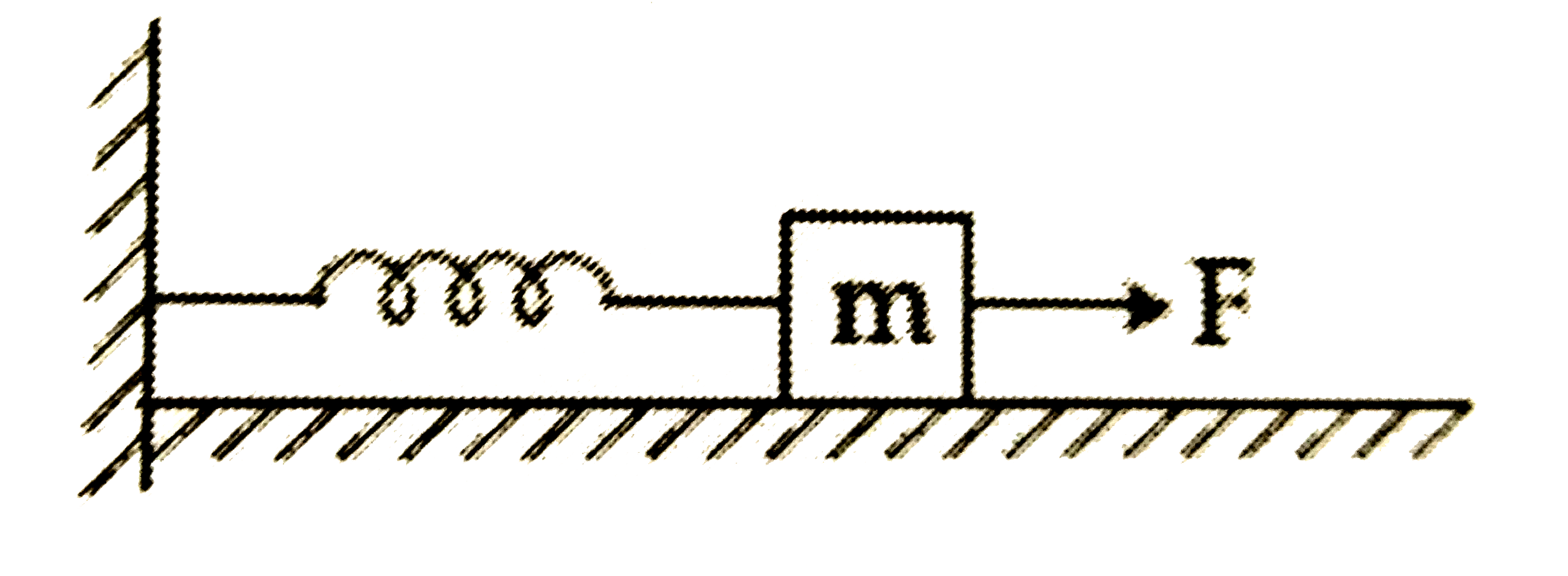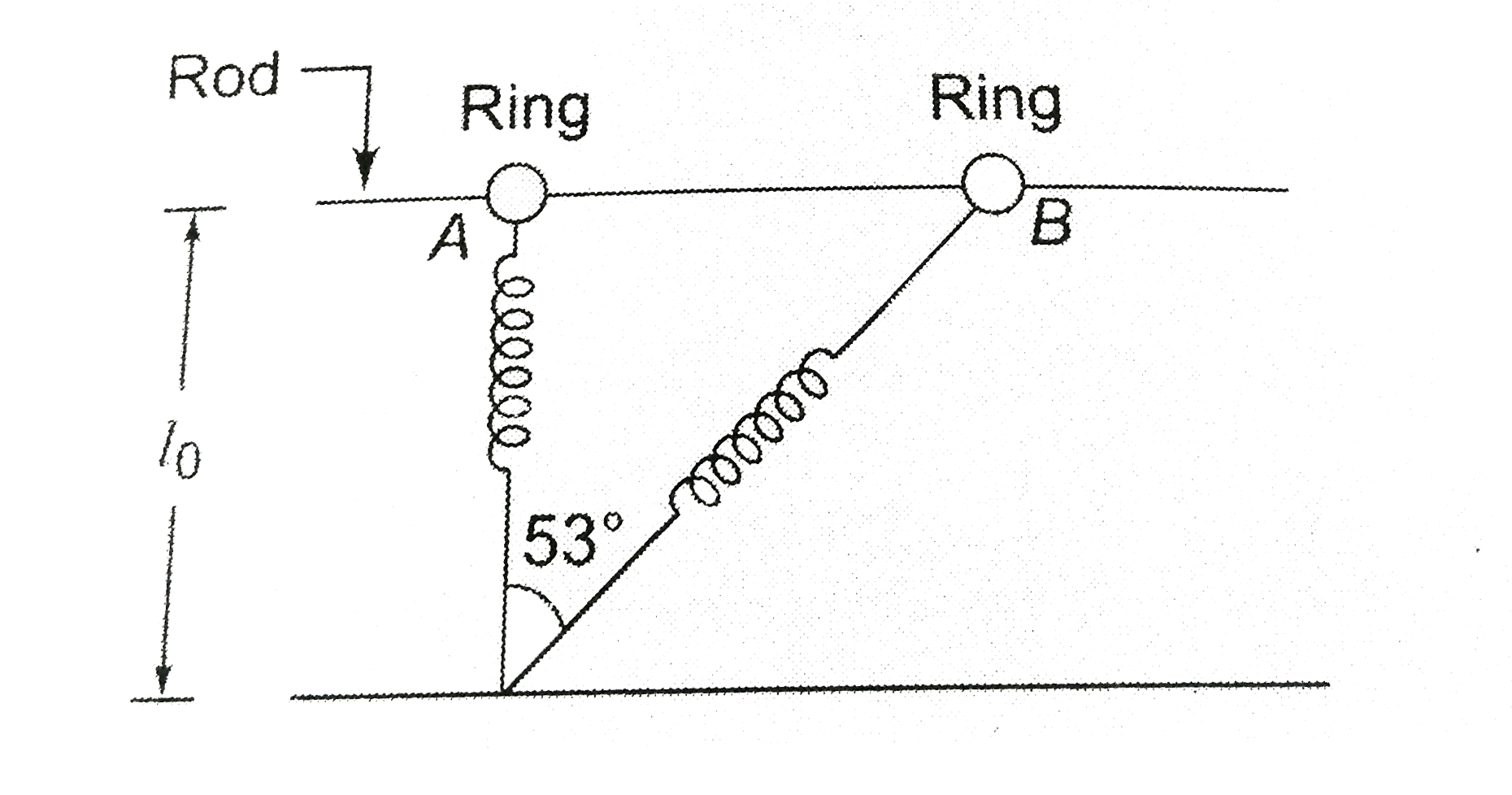A body of mass is tied to a spring of spring constant ,while the other end of spring is fixed at point .If the body moves about in a circular path on a smooth horizontal surface with constant angular speed .Find . with constant angular speed 5rad/s
0.086805555555556
0.043055555555556
2:3
0.042361111111111
To solve the problem, we need to find the ratio of the extension in the spring to its natural length when a body of mass 200 g is moving in a circular path with a constant angular speed of 5 rad/s.
1. Identify the Given Values:
- Mass of the body, m=200g=0.2kg
- Spring constant, k=12.5N/m
- Angular speed, ω=5rad/s
2. Understand the Forces Acting on the Body:
- The body is moving in a circular path, which means there is a centripetal force acting towards the center (point O).
- The spring provides the necessary centripetal force as it extends.
3. Centripetal Force Equation:
- The centripetal force required to keep the mass moving in a circular path is given by:
Fc=mω2r
- Here, r is the total length of the spring when extended, given by r=L+x where L is the natural length of the spring and x is the extension.
4. Spring Force Equation:
- The force exerted by the spring when it is extended is given by Hooke's Law:
Fs=kx
5. Setting the Forces Equal:
- For the body to move in a circular path, the centripetal force must equal the spring force:
kx=mω2(L+x)
6. Rearranging the Equation:
- Rearranging the equation gives:
kx=mω2L+mω2x
- This can be rewritten as:
kx−mω2x=mω2L
- Factoring out x:
x(k−mω2)=mω2L
- Thus, we have:
x=mω2Lk−mω2
7. Calculating the Values:
- First, calculate mω2:
mω2=0.2×(52)=0.2×25=5N
- Now substitute this into the equation:
x=5L12.5−5=5L7.5=2L3
8. Finding the Ratio of Extension to Natural Length:
- The ratio of the extension x to the natural length L is:
xL=2L/3L=23
Final Answer:
The ratio of the extension in the spring to its natural length is 23.
- Mass of the body, m=200g=0.2kg
- Spring constant, k=12.5N/m
- Angular speed, ω=5rad/s
- The body is moving in a circular path, which means there is a centripetal force acting towards the center (point O).
- The spring provides the necessary centripetal force as it extends.
- The centripetal force required to keep the mass moving in a circular path is given by:
Fc=mω2r
- Here, r is the total length of the spring when extended, given by r=L+x where L is the natural length of the spring and x is the extension.
- The force exerted by the spring when it is extended is given by Hooke's Law:
Fs=kx
- For the body to move in a circular path, the centripetal force must equal the spring force:
kx=mω2(L+x)
- Rearranging the equation gives:
kx=mω2L+mω2x
- This can be rewritten as:
kx−mω2x=mω2L
- Factoring out x:
x(k−mω2)=mω2L
- Thus, we have:
x=mω2Lk−mω2
- First, calculate mω2:
mω2=0.2×(52)=0.2×25=5N
- Now substitute this into the equation:
x=5L12.5−5=5L7.5=2L3
- The ratio of the extension x to the natural length L is:
xL=2L/3L=23
The ratio of the extension in the spring to its natural length is 23.
Topper's Solved these Questions
Similar Questions
Knowledge Check
A body of mass 20 g connected to a spring of spring constant k, executes simple harmonic motion with a frequency of (5/π) Hz. The value of spring constant is
A4Nm−1B3Nm−1C2Nm−1D5Nm−1If a body of mass 0.98 kg is made to oscillate on a spring of force constant 4.84 N/m the angular frequency of the body is
A1.22 rad/sB2.22 rad/sC3.22 rad/sD4.22 rad/sA block of mass m is attached to one end of a mass less spring of spring constant k. the other end of spring is fixed to a wall the block can move on a horizontal rough surface. The coefficient of friction between the block and the surface is μ then the compession of the spring for which maximum extension of the spring becomes half of maximum compression is .
A2mgμkBmgμkC4mgμkDNone of these
A block of mass m, attached to a spring of spring constant k, oscilltes on a smooth horizontal table. The other end of the spring is fixed to a wall. If it has speed v when the spring is at its naturla lenth, how far will it move on the table before coming to an instantaneous rest?
View SolutionA block of mass m, lying on a smooth horizontal surface, is attached to a spring (of negligible mass) of spring constant k. The other end of the spring is fixed, as shown in the figure. The block is initally at rest in its equilibrium position. If now the block is pulled withe a constant force F, the maximum speed of the block is :

View SolutionA block of mass m, lying on a smooth horizontal surface, is attached to a spring (of negligible mass) of spring constant k. The other end of the spring is fixed, as shown in the figure. The block is initally at rest in its equilibrium position. If now the block is pulled withe a constant force F, the maximum speed of the block is :

View Solution
A ring of mass m is attached to a horizontal spring of spring constant k and natural length l0. The other end of the spring is fixed and the ring can slide on a horizontal rod as shown. Now the ring is shifted to position B and released Find the speed of the ring when the spring attains its natural length.
View SolutionA body of mass 1 kg suspended by a light vertical spring of spring constant 100 N/m executes SHM. Its angular frequency and frequency are
View Solution